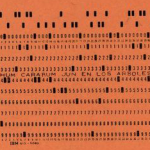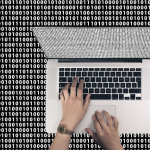electropoetics
At the Brink: Electronic Literature, Technology, and the Peripheral Imagination at the Atlantic Edge

In this keynote, presented at the 2019 Electronic Literature Organization conference in Cork, Ireland, Anne Karhio highlights the importance of electronic literature as no less peripheral in its own construction of social, cultural, networked communities and material geographies. By looking also at recent scholarship on digital infrastructures, media archaeology, and new materialist approaches to communications technology, Karhio delineates changes that emerge from the margins, "from experimentation and risk-taking that questions established conventions, and canons, and flickers at the border of the actual and the imaginary."
Electronic Literature Experimentalism Beyond the Great Divide. A Latin American Perspective

Given the longstanding but limited readership for North American, Euro and Scandinavian e-lit, will Latin America succeed in carrying its experimental and avant-garde approaches to a general e-lit audience? Claudia Kozak's expanded keynote for the 2018 ELO conference in Montreal, titled "Mind the Gap!", explores some first forays in this direction: practices that might hearken back to Puig and Borges in print; Omar Goncedo, Eduardo Darino, Erthos Albino de Souza and Jesús Arellano in the era of mainframes; and (not least) fan fiction over pretty much the entire span of literary writing.
Image: Omar Gancedo, IBM (1966).
At a Heightened Level of Intensity: A Discussion of the Philosophy and Politics of Language in John Cayley’s Digital Poetics

A conversation at a heightened level of intensity, ranging from the aleatory tradition of Emmett Williams, Jackson Mac Low, and John Cage, through post-Poundian poetry and its Chinese influences, kinetic poetry or programmable media where the poem itself is performing, not just the poet. Attention is also given to the Internet as these two literary artists knew it for a very brief moment, before Google and Facebook, circa 2004, "figured out that everybody needed an account."
Many Lives to Live

This review of Intermedia, Fluxus and the Something Else Press: Selected Writings by Dick Higgins, co-edited by Steve Clay and Ken Friedman, is itself a collaboration between Virginia Kuhn and Betsy Sullivan. Both approaches, to the review and the book here under consideration, capture the importance of community in creating and sustaining the art of Intermedia, Fluxus, and the Something Else Press.
Digital Writing: Philosophical and Pedagogical Issues

Bouchardon and Petit defend the concept of digital writing and the teaching thereof. We can accept that digital writing exists, with its specific properties and tensions, but can it be taught? Specifically, the pedagogical dimension of what is known as "digital" writing, the authors argue, would do well to follow a study on the relationship between writing and computer science that was sponsored by the Picardy region : PRECIP, PRatiques d'ÉCriture Interactive en Picardie (interactive writing practices in Picardy).